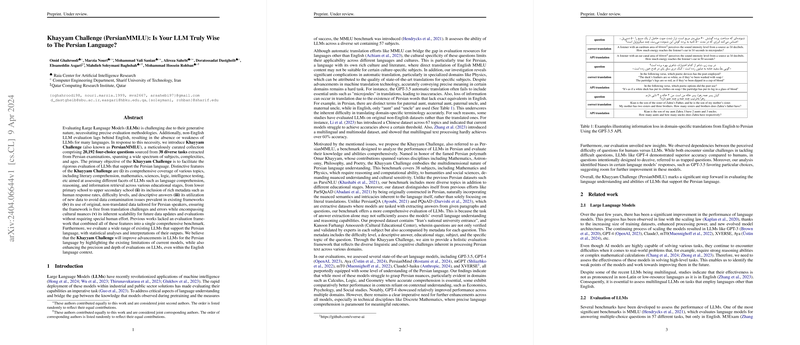Evaluation and Insights from the Khayyam Challenge: A Benchmark for Persian Language Understanding in LLMs
Introduction
The landscape of LLMs evaluation has been enriched with the introduction of the Khayyam Challenge, also known as PersianMMLU. This comprehensive benchmark aims to rigorously assess LLMs' understanding of the Persian language through a diverse array of subjects and complexities. The challenge is named after Omar Khayyam, reflecting the multidisciplinary nature of the tasks it comprises. Unique in its construction, the Khayyam Challenge leverages questions sourced from the Iranian educational context, extending from lower primary to upper secondary education levels. This initiative addresses critical gaps in non-English LLM evaluations and sets the stage for future advancements in Persian language processing.
Data Characteristics
The dataset, derived from Iran's "Pellekan Yadgiri" website and the esteemed Kanoon Farhangi Amoozesh, spans 38 subjects with a total of 20,192 four-choice questions. These subjects range widely from mathematics and science to humanities, each requiring a mix of language comprehension, reasoning, and knowledge retrieval. Notable for its high-quality and expert-validated content, Khayyam Challenge stands out by including:
- Rich Metadata: Information on difficulty levels, educational stages, and detailed explanations for each question.
- Original, Non-Translated Content: Specifically tailored for Persian, avoiding the common pitfalls of translated data.
- Comprehensive Coverage and Scalability: From literary comprehension to logical reasoning across various educational stages.
Evaluation Methodology
The paper describes a meticulous evaluation of several state-of-the-art LLMs, including GPT-3.5 and GPT-4, across this comprehensive dataset. A significant part of this paper is the use of different methods for answer extraction, like Regex and Probability approaches, alongside traditional performance metrics. Notably, the analysis includes a detailed comparison of LLMs' performance against human benchmarks, shedding light on current models' limitations and areas requiring improvement.
Observations and Insights
The results presented underscore several important findings:
- Performance Gaps: LLMs, including GPT-4, demonstrated promising yet still lagging performance compared to human benchmarks. This discrepancy was particularly noticeable in tasks requiring advanced reasoning, such as those in the mathematics and natural sciences categories.
- Model Comparisons: Among the evaluated models, GPT-4 showed superior performance, yet with a noted need for enhancement to reach human-like understanding and reasoning in Persian.
- Rich Metadata Utilization: The analysis of metadata, such as question difficulty and the presence of traps, provided deeper insights into the models' operational nuances.
Implications for Future Research
The Khayyam Challenge not only marks a significant advancement in evaluating Persian language understanding in LLMs but also opens several avenues for future research. The detailed insights into model performances and the comprehensive nature of the dataset pave the way for targeted improvements in model architectures and training methodologies. Moreover, the scalable framework of the Khayyam Challenge allows for easy updates and expansions, ensuring its relevance and utility in the fast-evolving field of AI and language understanding.
Concluding Remarks
In summary, the Khayyam Challenge represents a pivotal step towards a deeper and more nuanced understanding of Persian language processing in LLMs. By offering a rigorous, varied, and scalable benchmark, it provides a valuable resource for researchers aiming to push the boundaries of AI language capabilities. The insights gained from this challenge highlight the existing gaps in LLMs' understanding and reasoning in Persian, offering clear directions for future advancements in the field.
